一、@try/@catch/@throw/@finally 执行顺序
objectivec
void doSomething() {
NSAutoreleasePool *pool = [[NSAutoreleasePool alloc] init];
@try {
// 这一步抛异常
[self riskyMethod];
} @catch (NSException *e) {
@throw; // 把异常继续往上抛
} @finally {
// ❗ 注意:这里的 finally 会 **立刻执行**
[pool release]; // 🔥🔥🔥 外层 pool 提前 pop 了
}
// ❌ 如果你此时还没处理完那个 exception,它里面的对象已经被释放了
}
1. riskyMethod 抛出异常
2. 进入 @catch 块
3. @catch 里调用了 @throw(重新抛出)
4. ❗ 根据编译器实现,@finally 会 **立刻执行**
⬅️ 在这个"再抛之前",@finally 就执行了
5. @finally 执行时,释放了 autorelease pool
6. ❌ 异常对象(NSException 实例)可能在 autorelease pool 中,它被提前释放了
7. 异常还没被真正交到上层 catch,就已经是 zombie 了二、try-catch 内存管理(坑)
1、普通内存泄漏
1.1. 如何泄漏
objectivec
- (void)doSomething {
NSMutableArray *anArray = [[NSMutableArray alloc] initWithCapacity:0];
@try {
[self doSomethingElse:anArray]; // 假设一定会抛错
} @catch(...) {
@throw;
}
[anArray release];
}就像这种情况,我在 catch 里又重新抛异常,那么就会导致 [anArray release]; 就不会被执行了,所以 anArray 就会内存泄漏了。
1.2. 解决方案
objectivec
- (void)doSomething {
NSMutableArray *anArray = [[NSMutableArray alloc] initWithCapacity:0];
@try {
[self doSomethingElse:anArray]; // 假设一定会抛错
} @catch(...) {
@throw;
} @finally {
[anArray release];
}
}2、提前释放 auto release pool 引起的内存泄漏
2.1. 如何泄漏
objectivec
- (void)doSomething {
NSAutoreleasePool *pool = [[NSAutoreleasePool alloc] init];
NSException *ex = [NSException exceptionWithName:@"MyError" reason:nil userInfo:nil]; // 创建 NSException,retain 一次,retainCount + 1
@throw ex; // 由 runtime retain 1 次,retainCount + 2
[pool release]; // 不会执行
}
@try {
[someObject doSomething]; // 抛出 ex
} @catch (NSException *e) {
@throw; // 再次抛出 ex,但这是 rethrow, retainCount 不会加 1
} @finally {
[outerPool release]; // 释放 ex 所在 autorelease pool,retainCount - 1;
// 因为 ex 是通过 unwind 找到当前栈帧的,且当前栈帧有 @finally,
// 所以会调一次 runtime cleanup 来清理对象,retainCount - 1;
// 此时 ex 的 retainCount 为 0,ex 被 dealloc
}因为 doSomething: 函数内部创建了一个 auto release pool;而且外层又有一个 auto release pool,所以这两个 auto release pool 是这样的:

然后 ex 的引用计数看注释就可以了。顺带提一下,只要是被 unwind 到当前栈帧且当前栈帧有 @finally,系统就会在 finally 块里调 cleanup 函数,给当前所有对象的 retain count 减 1.
那什么时候会被 unwind 呢?其实就是当异常对象被 throw 或当前函数栈帧无法捕获异常时,系统就会调unwind 来一个个函数栈帧往上找。只要当前栈帧(没有 throw 的栈帧)的 catch 能捕获到异常且 catch 不再重新抛出异常,unwind 就不会继续被调。
2.2. 解决方案
objectivec
- (void)doSomething {
NSAutoreleasePool *pool = [[NSAutoreleasePool alloc] init];
NSException *ex = [NSException exceptionWithName:@"MyError" reason:nil userInfo:nil];
@throw ex;
[pool release]; // 不会执行
}
@try {
[someObject doSomething]; // 抛出 ex
} @catch (NSException *e) {
[e retain];
@throw;
} @finally {
[outerPool release];
}是的,就是给 e 的 retainCount 多加 1 就可以了。这样就可以给整个异常对象的引用计数加 1,不让他被 dealloc 掉。
三、性能对比:32 位的 try-catch VS 64 位的 try-catch
先提前下个结论:根据苹果开发者文档,其实 32 位跟 64 位的 try-catch 各有利弊。因为苹果针对 64 位情况重新实现了 objective-c 的异常处理机制,也就是说采用了 cpp 的 zero-cost 的异常处理机制;因此,32 位的 try-catch 在 try 的部份性能比 64 位的 try 部份差;而 64 位的 throw 部份会比 32 位的 throw 部份差。下面我会分别讲这两部分性能差异的原理。不过先叠个甲,里面的伪代码实现都是用于逻辑自洽的,语法上难免会有错误。
1、32 位下 objective-c 的异常处理机制
其实在 32 位下 objective-c 的异常处理机制是这样的:每进入一个 @try 块,都会先创建一个异常栈帧(不是函数的栈帧),把当前 @try 代码块的地址写到 jmp_buf env 里,然后再调 setjmp 函数来标记 longjmp() 应该跳到的地方。
对于每一个 throw 函数,都会调 longjmp() 函数,然后让程序的 pc 指针指向当前异常栈帧的 setjmp(frame.env) 处。因为 setjmp(frame.env) 此时返回值不是 0,所以跳到 catch 执行......然后一直沿着 try 的调用链往上找 catch。
cpp
typedef struct ExceptionFrame {
jmp_buf env;
struct ExceptionFrame *prev;
const char *handledType; // 这个 try 块能处理的异常类型
Exception *caughtException; // 用于传值给 catch
} ExceptionFrame;
__thread ExceptionFrame *topFrame = NULL; // 每个线程一份
cpp
// try 的伪代码实现
#define TRY(type) do { \
ExceptionFrame frame; \
frame.prev = topFrame; \
frame.handledType = type; \
frame.caughtException = NULL; \
topFrame = &frame; \
if (setjmp(frame.env) == 0)
#define CATCH(x) else for (Exception *x = frame.caughtException; x != NULL; x = NULL)
#define END_TRY \
topFrame = frame.prev; \
} while (0)
// throw 的伪代码实现
#define THROW(e) do { \
currentException = e; \
ExceptionFrame *frame = topFrame; \
while (frame) { \
if (strcmp(frame->handledType, e->type) == 0 || strcmp(frame->handledType, "*") == 0) { \
frame->caughtException = e; \
topFrame = frame->prev; \
longjmp(frame->env, 1); \
} \
frame = frame->prev; \
} \
fprintf(stderr, "Uncaught exception: %s\n", e->message); \
abort(); \
} while (0)
cpp
TRY {
// 这里写 try 块的内容
maybeDangerousFunction();
THROW(&someException);
} CATCH(e) {
} END_TRY;2、64 位下 objective-c 的异常处理机制
但是在 64 位下 objective-c 的异常处理用的是 zero-cost 那套,也就是每进入一个 try 块时并不会创建一个 exception frame。但一旦遇到 throw 时,就会从当前函数栈帧开始,找每个栈帧的匹配的 catch 块,找不到就再去上一个函数栈帧找。
cpp
struct StackFrame {
StackFrame *prev; // 栈上的上一个帧
FunctionMeta *functionMeta; // 指向 LSDA + handler 信息
void *pc; // 当前执行地址 (程序计数器)
};
struct Exception {
const char *type;
const char *message;
};
typedef struct {
char *type; // 异常类型
void (*handler)(Exception*); // catch handler 跳转landing pad
void (*cleanup)(void); // cleanup handler,例如 finally
int hasCleanup; // 是否有 cleanup
} CatchClause;
struct FunctionMeta {
CatchClause *clauses; // 存 catch 代码块地址的数组,一个 catch 对应一个 clause
int clauseCount;
void (*personality)(StackFrame *, Exception *);
};
cpp
// 默认的 personality 函数,带 cleanup 处理
void defaultPersonality(StackFrame *frame, Exception *e) {
int handled = 0; // 该层栈帧的 catch 能否捕获异常,可以为 1,不可以为 0
// 先查找 catch clause
for (int i = 0; i < frame->functionMeta->clauseCount; ++i) {
CatchClause *clause = &frame->functionMeta->clauses[i];
if (strcmp(clause->type, e->type) == 0) {
// 找到匹配的 catch
clause->handler(e); // 执行 catch handler(landing pad)
handled = 1;
break;
}
}
// 调用 cleanup handler(无论 catch 是否找到都会调用 cleanup)
for (int i = 0; i < frame->functionMeta->clauseCount; ++i) {
CatchClause *clause = &frame->functionMeta->clauses[i];
if (clause->hasCleanup && clause->cleanup != nullptr) {
clause->cleanup(); // 执行 cleanup,比如 finally
}
}
if (!handled) {
// 当前栈帧不能处理异常,继续向上 unwind
unwind(frame->prev, e);
}
}
// throw 异常时当前栈帧直接调 unwind,可以看成 defaultPersonality 是私有的
void unwind(StackFrame *frame, Exception *e) {
if (!frame) {
printf("Uncaught exception: %s\n", e->message);
abort();
}
frame->functionMeta->personality(frame, e);
}unwind 执行什么呢?就是先看看当前栈帧有没有符合类型的 catch 可以捕获异常;然后在看看当前栈帧有没有 finally,有的话就调 cleanup();然后如果当前栈帧可以捕获异常,不继续调 unwind ,否则继续调上一个栈帧的 unwind.
3、性能差异原因
所以 32 位下 oc 的 try 比 64 的 try 性能消耗更大是因为 32 位下 oc 会给每一个 try 块创建一个叫 jmp_buf env 的东西,而且还会调一次 setjmp() ;但 64 位对每一个 try 块并不会做任何事,所以 32 位下 try 块会比 64 位需要更多的内存。
那 64 位的 throw 比 32 位的 throw 性能更差是因为 32 位下用的是 exception frame + longjmp() 来跳转,每一跳肯定可以跳到最近有 catch 的函数栈帧中,所以 32 位找对应 catch 所花的时间是比 64 位一个一个栈帧找要快的。